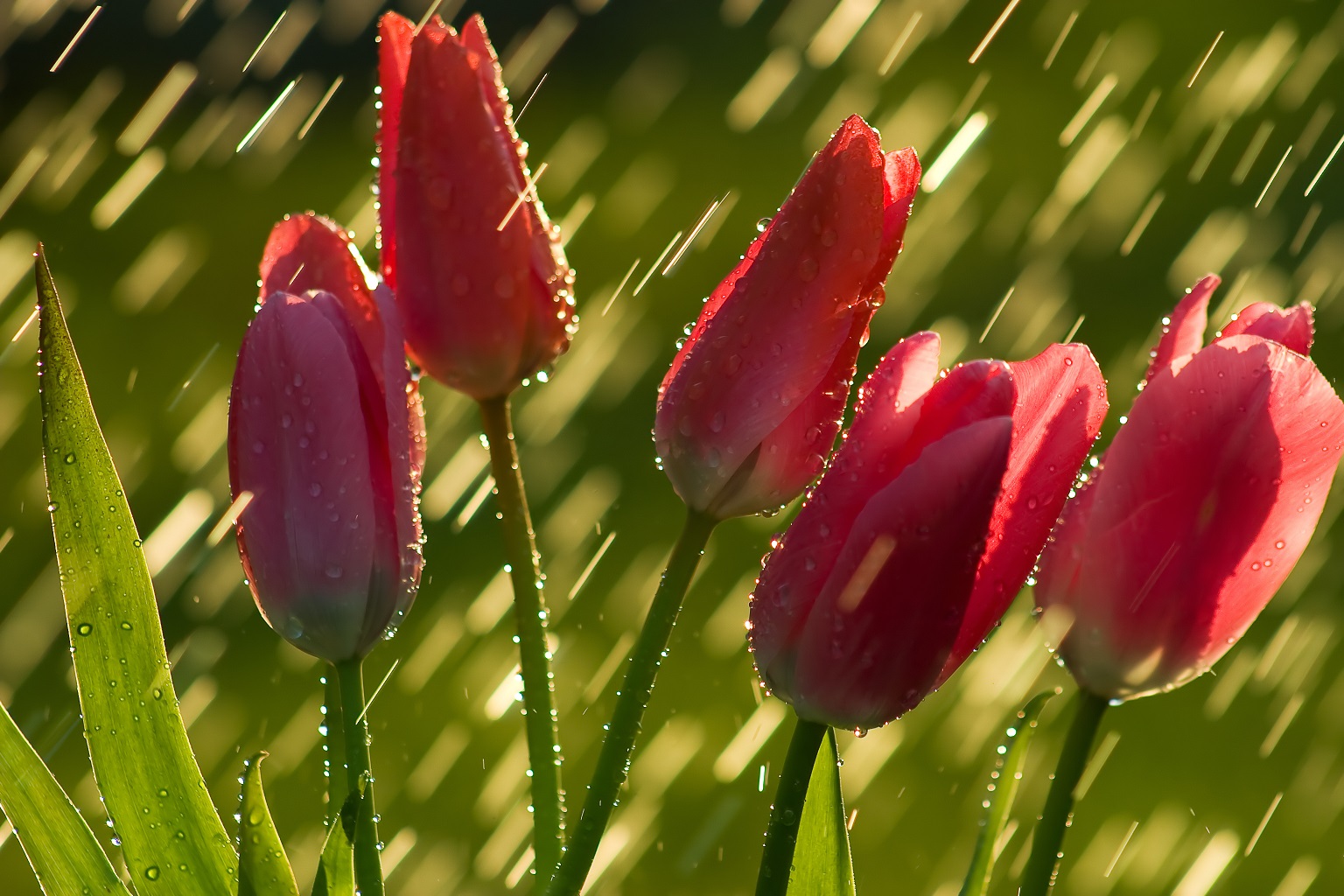
By Staff Middle Land
By Allen L Phillips
We’ve always noticed the effect of rainwater on our gardens over the years. There’s just something about it that plants love. So it was with some anticipation that we set out the last week of April to visit Pat’s step-daughter in San Jose, and my daughter in San Francisco. We picked this time to make the drive up old Route 101 because the landscape between Los Angeles and the bay area is so beautiful in the spring. Our expectations were high, due to the exceptionally wet winter, and we weren’t disappointed.
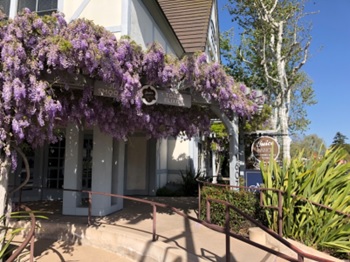
North of L. A. we went through the San Fernando Valley to the coast at Ventura and along the ocean to Santa Barbara where the hills inland were streaked yellow with wild mustard. In Santa Barbara we turned right on Highway 154 to Solvang where we overnight to break up the drive. This beautiful drive up through the hills, where it seemed everything was blooming, took us past Lake Cachuma, near capacity from that rainwater thing.
After checking in at the King Frederik Inn we walked around the unique village of Solvang, with its Danish architecture including an occasional windmill. Our timing was perfect to catch the wisteria in full bloom on several store fronts, all the brighter because of the rains.
We had reservations for dinner at Los Olivos Wine Merchant Cafe, east of Solvang past vineyards and horse ranches, and scored a table on their front porch surrounded by more blooming wisteria. Gaining sudden fame with the release of the movie “Sideways” in 2004, people first came because it was featured in the movie. Now they come because it’s good.
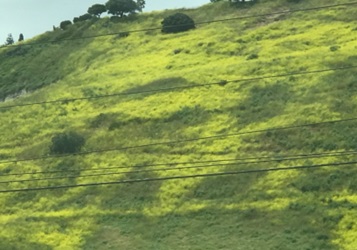
The next morning we headed north through Santa Maria, touching the ocean again at San Luis Obisbo, then turning inland through Atascadero, Paso Robles, King City, Salinas and Gilroy before approaching San Jose and the Bay Area. All along this drive we are stunned by the beauty; rolling green hills studded with California Live Oaks and grazing cattle; cropland in full spring growth; and everywhere artwork on the hillsides in streaks and swirls like the works of Vincent Van Gogh. Our photos taken from the car don’t do it justice.
Our visit with my daughter and her husband was wonderful and their long, major, remodel of their home is finally nearing completion. They have done some amazing work and, with the heavy lifting done, the finish work will soon be over and they can kick back and enjoy it. They have earned it. In addition to restaurants that only locals know they showed us some sights we hadn’t seen before:
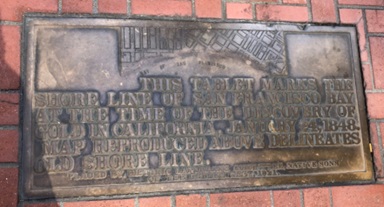
Downtown, a few blocks from the embarcadero, is a small square that commemorates the original shoreline of the bay before the Gold Rush. Hoards of people arrived in 1849 and many abandoned their boats in the bay. City fathers then hauled in dirt, buried the unsightly boats and moved the bay front a few blocks east. This little park, where Market, Bush and Battery streets intersect, has map displays, a plaque and 2 beach chairs for photo ops.
The San Francisco Palace of Fine Arts was built for the 1915 Panama-Pacific Exposition, a world’s fair held in San Francisco, and showed that they had survived the devastating 1906 earthquake and fire and were back in business. The centerpiece is the beautiful and elaborate Greco-roman structure fronting a lagoon in the Marina District. Completely rebuilt in the 1970’s, this amazing structure hides a large exhibition hall behind it’s curving colonnades.
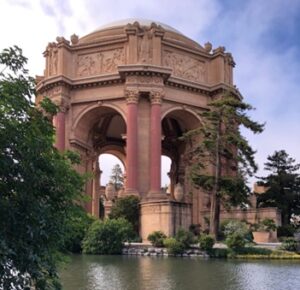
We also spent several afternoons in San Jose with Pat’s step daughter and her two sons, one in college studying space science and the other a junior in high school and running track. He qualified for the 4 by 400 relay in an invitational meet where he ran anchor. We hadn’t watched a track meet in years and it was great to see the dedication of these kids.
Then we started the drive back and something was different – colors seemed brighter – our drive up had been sunny – the drive back more overcast, a threat of more rain chasing us south. Had the mustard grown that much in a week, becoming a brighter yellow? It’s that rainwater thing. We watched this visual feast with awe and were so enraptured by the scenery that the miles rolled by and we arrived back in Solvang ahead of schedule for our overnight rest.
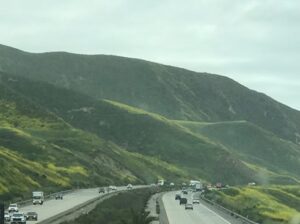
Heading on to San Diego the next day, we realized that everywhere the freeway cut through a hill, the slopes on either side had become canvases for nature’s artwork. I doubt that the seed mix sprayed on these slopes during construction included wild mustard. But mustard was the show now with little yellow puff balls on the end of tall spindly stems quivering in the wind as they reach for the sky.
At a view point at Camp Pendleton we watched gulls surfing the on-shore winds hoping for handouts from people who had stopped to stretch their legs. Even here brushstrokes of mustard surrounded us.
Back home in our complex, looking east at the hill behind us, the mustard is still stretching toward the heavens.
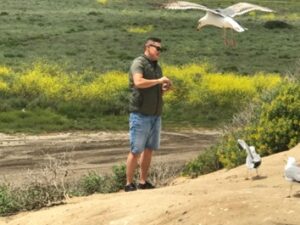
And about that rainwater thing – why do plants love it? According to Mr. Google: First, it doesn’t have all those nasty additives from water treatment; Second, it is slightly acidic, a good thing; Third, it naturally contains nitrates, another good thing; Lastly, it usually washes off organic matter from roofs and foliage, left there by recent visitors, which nourishes the soil.
So from now on when rain is forecast, I will count my blessings.
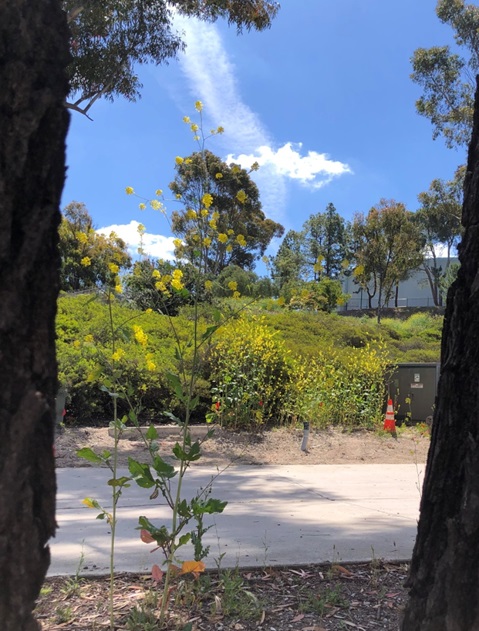








Cancel anytime


Using our website
You may use the The Middle Land website subject to the Terms and Conditions set out on this page. Visit this page regularly to check the latest Terms and Conditions. Access and use of this site constitutes your acceptance of the Terms and Conditions in-force at the time of use.
Intellectual property
Names, images and logos displayed on this site that identify The Middle Land are the intellectual property of New San Cai Inc. Copying any of this material is not permitted without prior written approval from the owner of the relevant intellectual property rights.
Requests for such approval should be directed to the competition committee.
Please provide details of your intended use of the relevant material and include your contact details including name, address, telephone number, fax number and email.
Linking policy
You do not have to ask permission to link directly to pages hosted on this website. However, we do not permit our pages to be loaded directly into frames on your website. Our pages must load into the user’s entire window.
The Middle Land is not responsible for the contents or reliability of any site to which it is hyperlinked and does not necessarily endorse the views expressed within them. Linking to or from this site should not be taken as endorsement of any kind. We cannot guarantee that these links will work all the time and have no control over the availability of the linked pages.
Submissions
All information, data, text, graphics or any other materials whatsoever uploaded or transmitted by you is your sole responsibility. This means that you are entirely responsible for all content you upload, post, email or otherwise transmit to the The Middle Land website.
Virus protection
We make every effort to check and test material at all stages of production. It is always recommended to run an anti-virus program on all material downloaded from the Internet. We cannot accept any responsibility for any loss, disruption or damage to your data or computer system, which may occur while using material derived from this website.
Disclaimer
The website is provided ‘as is’, without any representation or endorsement made, and without warranty of any kind whether express or implied.
Your use of any information or materials on this website is entirely at your own risk, for which we shall not be liable. It is your responsibility to ensure any products, services or information available through this website meet your specific requirements.
We do not warrant the operation of this site will be uninterrupted or error free, that defects will be corrected, or that this site or the server that makes it available are free of viruses or represent the full functionality, accuracy and reliability of the materials. In no event will we be liable for any loss or damage including, without limitation, loss of profits, indirect or consequential loss or damage, or any loss or damages whatsoever arising from the use, or loss of data, arising out of – or in connection with – the use of this website.
Last Updated: September 11, 2024
New San Cai Inc. (hereinafter “The Middle Land,” “we,” “us,” or “our”) owns and operates www.themiddleland.com, its affiliated websites and applications (our “Sites”), and provides related products, services, newsletters, and other offerings (together with the Sites, our “Services”) to art lovers and visitors around the world.
This Privacy Policy (the “Policy”) is intended to provide you with information on how we collect, use, and share your personal data. We process personal data from visitors of our Sites, users of our Services, readers or bloggers (collectively, “you” or “your”). Personal data is any information about you. This Policy also describes your choices regarding use, access, and correction of your personal information.
If after reading this Policy you have additional questions or would like further information, please email at middleland@protonmail.com.
PERSONAL DATA WE COLLECT AND HOW WE USE IT
We collect and process personal data only for lawful reasons, such as our legitimate business interests, your consent, or to fulfill our legal or contractual obligations.
Information You Provide to Us
Most of the information Join Talents collects is provided by you voluntarily while using our Services. We do not request highly sensitive data, such as health or medical information, racial or ethnic origin, political opinions, religious or philosophical beliefs, trade union membership, etc. and we ask that you refrain from sending us any such information.
Here are the types of personal data that you voluntarily provide to us:
As a registered users or customers, you may ask us to review or retrieve emails sent to your business. We will access these emails to provide these services for you.
We use the personal data you provide to us for the following business purposes:
Information Obtained from Third-Party Sources
We collect and publish biographical and other information about users, which we use to promote the articles and our bloggers who use our sites. If you provide personal information about others, or if others give us your information, we will only use that information for the specific reason for which it was provided.
Information We Collect by Automated Means
Log Files
The site uses your IP address to help diagnose server problems, and to administer our website. We use your IP addresses to analyze trends and gather broad demographic information for aggregate use.
Every time you access our Site, some data is temporarily stored and processed in a log file, such as your IP addresses, the browser types, the operating systems, the recalled page, or the date and time of the recall. This data is only evaluated for statistical purposes, such as to help us diagnose problems with our servers, to administer our sites, or to improve our Services.
Do Not Track
Your browser or device may include “Do Not Track” functionality. Our information collection and disclosure practices, and the choices that we provide to customers, will continue to operate as described in this Privacy Policy, whether or not a “Do Not Track” signal is received.
HOW WE SHARE YOUR INFORMATION
We may share your personal data with third parties only in the ways that are described in this Privacy Policy. We do not sell, rent, or lease your personal data to third parties, and We does not transfer your personal data to third parties for their direct marketing purposes.
We may share your personal data with third parties as follows:
There may be other instances where we share your personal data with third parties based on your consent.
HOW WE STORE AND SECURE YOUR INFORMATION
We retain your information for as long as your account is active or as needed to provide you Services. If you wish to cancel your account, please contact us middleland@protonmail.com. We will retain and use your personal data as necessary to comply with legal obligations, resolve disputes, and enforce our agreements.
All you and our data are stored in the server in the United States, we do not sales or transfer your personal data to the third party. All information you provide is stored on a secure server, and we generally accepted industry standards to protect the personal data we process both during transmission and once received.
YOUR RIGHTS/OPT OUT
You may correct, update, amend, delete/remove, or deactivate your account and personal data by making the change on your Blog on www.themiddleland.com or by emailing middleland@protonmail.com. We will respond to your request within a reasonable timeframe.
You may choose to stop receiving Join Talents newsletters or marketing emails at any time by following the unsubscribe instructions included in those communications, or you can email us at middleland@protonmail.com
LINKS TO OTHER WEBSITES
The Middle Land include links to other websites whose privacy practices may differ from that of ours. If you submit personal data to any of those sites, your information is governed by their privacy statements. We encourage you to carefully read the Privacy Policy of any website you visit.
NOTE TO PARENTS OR GUARDIANS
Our Services are not intended for use by children, and we do not knowingly or intentionally solicit data from or market to children under the age of 18. We reserve the right to delete the child’s information and the child’s registration on the Sites.
PRIVACY POLICY CHANGES
We may update this Privacy Policy to reflect changes to our personal data processing practices. If any material changes are made, we will notify you on the Sites prior to the change becoming effective. You are encouraged to periodically review this Policy.
HOW TO CONTACT US
If you have any questions about our Privacy Policy, please email middleland@protonmail.com
The Michelin brothers created the guide, which included information like maps, car mechanics listings, hotels and petrol stations across France to spur demand.
The guide began to award stars to fine dining restaurants in 1926.
At first, they offered just one star, the concept was expanded in 1931 to include one, two and three stars. One star establishments represent a “very good restaurant in its category”. Two honour “excellent cooking, worth a detour” and three reward “exceptional cuisine, worth a
Thank you for your participation,
please Log in or Sign up to Vote

123Sign in to your account